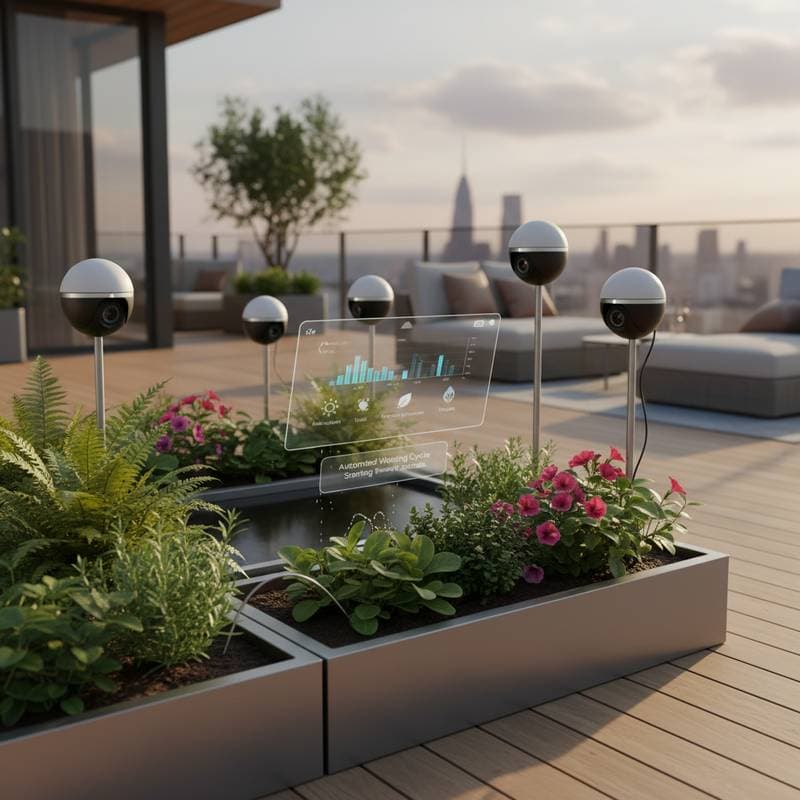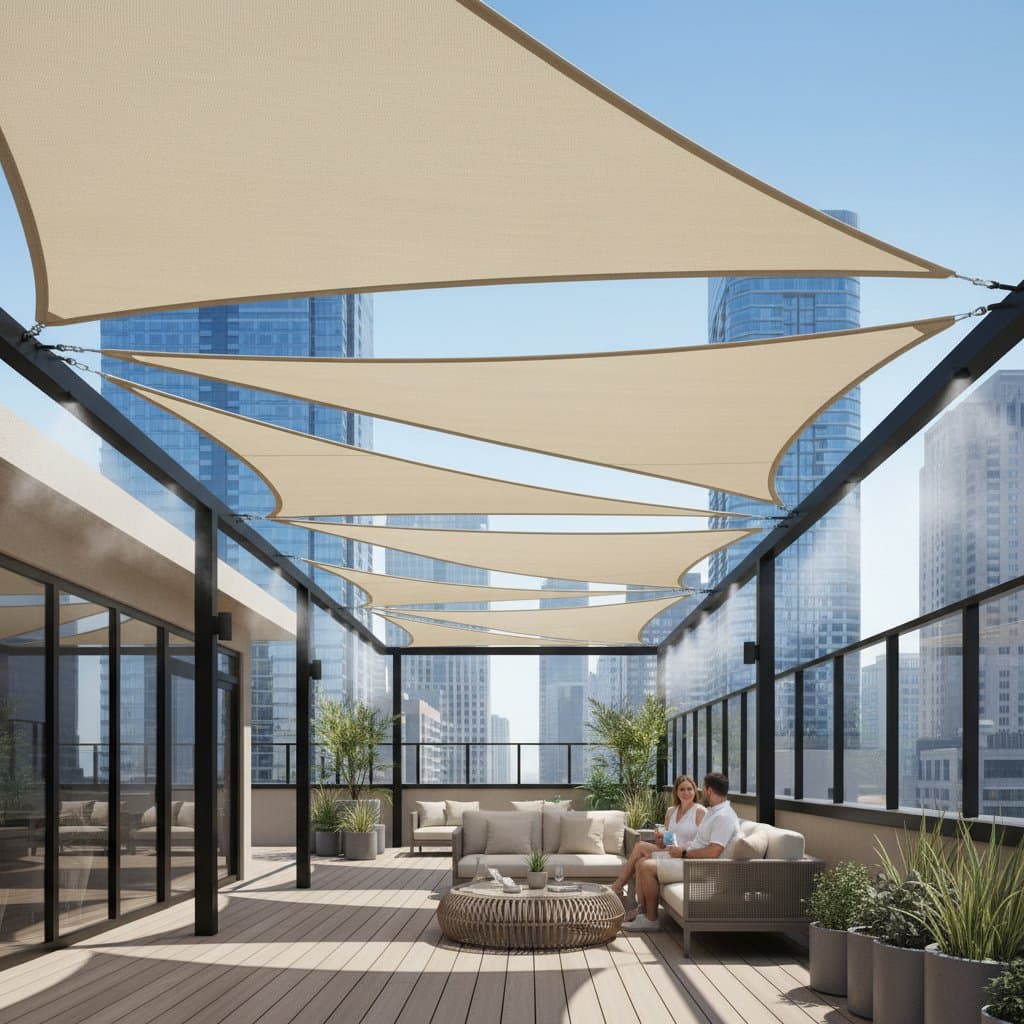Cool Urban Rooftops with Solar Misting: Reduce Temperatures by 20 Degrees
Urban summers transform rooftops into intense heat sources. Dark surfaces absorb sunlight rapidly, trapping warmth that elevates indoor temperatures and increases energy demands. Effective cooling solutions enhance comfort, extend roof longevity, and lower utility costs.
Solar misting systems address these challenges through evaporation-driven cooling. This guide details the principles behind the technology, installation process, required materials, and ongoing care. Readers gain practical knowledge to implement a self-sustaining system tailored to city rooftops.
System Fundamentals
A solar misting system deploys fine water droplets via specialized nozzles to cover rooftop areas. Solar panels power the operation, eliminating reliance on grid electricity. As droplets evaporate, they absorb heat from surfaces and surrounding air, achieving temperature reductions of up to 20 degrees Fahrenheit, or approximately 11 degrees Celsius.
Rooftops in densely populated areas experience extreme heat buildup due to limited airflow and material properties. This heat transfers indoors, straining cooling systems. Misting disrupts this process by creating a cooling barrier on the surface.
Primary advantages encompass:
- Enhanced surface temperatures for safer, more enjoyable spaces
- Diminished heat infiltration into buildings
- Decreased reliance on mechanical air conditioning
- Operation powered entirely by renewable energy
- Straightforward assembly requiring basic plumbing skills
Activation yields rapid results, with cooling effects evident shortly after mist deployment. The sensation resembles a light, refreshing spray, concentrated on the rooftop rather than dispersed broadly.
Essential Components and Tools
Assemble a foundational solar misting system using accessible, durable parts. Pre-packaged kits simplify the process, though custom configurations allow for precise adaptation to roof dimensions.
Core elements include:
- Solar panel with 10- to 25-watt capacity, scaled to pump requirements
- Low-pressure pump designed for solar input
- 1/4-inch flexible tubing for water distribution
- Brass or stainless steel misting nozzles, positioned 2 to 3 feet apart
- Water reservoir or direct hose hookup
- Timer mechanism or manual valve for operation control
- Mounting clips and zip ties for secure installation
Supporting tools consist of:
- Adjustable wrench for connections
- Tubing cutter or sharp scissors
- Drill equipped with a small bit for pilot holes
- Sturdy ladder and safety harness for elevated access
Verify roof compatibility prior to installation. Ensure materials withstand moisture and minor weight from components without damage to protective layers.
Installation Process
Layout Planning
Begin by diagramming the rooftop area. Identify zones with maximum sun exposure and frequent use, such as lounging spots or equipment locations. Position nozzle lines to target these areas while minimizing tubing length to preserve water pressure.
Solar Panel Installation
Select a location receiving at least six hours of direct sunlight daily. Secure the panel using manufacturer brackets, tilting it southward for optimal capture. Route wiring along edges, fastening with clips to prevent movement or hazards.
Pump Integration
Position the pump adjacent to the water supply. For reservoir use, place it on a shaded, stable platform to maintain water temperature. Link the pump to the solar panel via provided cables.
Safety Consideration: Disconnect the solar panel from all connections before handling wires to avoid electrical hazards, as panels generate current under sunlight.
Tubing and Nozzle Setup
Measure and cut tubing according to the planned paths. Insert nozzles into the lines using push-fit methods or kit connectors. Fasten tubing to railings or edges with clips spaced every 2 feet, directing nozzles outward for uniform coverage.
Water Connection and Initial Testing
Link tubing to the pump outlet. Incorporate a filter if connecting to a hose to block debris. Activate water flow and run the pump for one minute, inspecting for leaks and spray consistency. Refine nozzle angles for balanced distribution.
Operation Configuration
Employ a manual valve to regulate mist intensity. Schedule intermittent cycles of 10 to 15 minutes for sustained cooling. Program any integrated timer to engage during peak afternoon temperatures.
Safety Consideration: Ensure water supply precedes pump activation to prevent dry running, which damages components.
Essential Safety Practices
Prioritize precautions during setup and use:
- Select footwear with strong grip for wet conditions.
- Maintain distance from roof perimeters during adjustments.
- Isolate the solar panel prior to any servicing.
- Employ filtered water sources to minimize nozzle scaling.
- Position electrical elements above potential water paths, enclosed in sealed housings.
Common Issues and Resolutions
Weak or Inconsistent Spray: Inspect nozzles for blockages. Soak affected units in vinegar for 10 minutes, then rinse thoroughly before reattachment.
Pump Failure to Operate: Verify panel exposure to sunlight. Measure output voltage with a multimeter. Clean the panel or inspect wiring if power is absent.
Surface Water Accumulation: Redirect nozzles or lower flow rates. Clear roof drains to facilitate runoff.
Excessive Mist Density: Install a finer nozzle set rated at 0.3 gallons per hour or adjust pressure via the valve.
Routine Maintenance
Sustain system performance with regular attention.
- Weekly: Clean nozzles by wiping away accumulated residue.
- Monthly: Examine tubing for wear or disconnections.
- Seasonally: Flush lines with fresh water to eliminate buildup.
- Prior to Off-Season Storage: Detach the pump, empty all tubing, and organize components neatly.
Monthly solar panel checks involve removing debris with mild soap solution to preserve energy conversion efficiency.
Off-Season Storage
For periods of inactivity, disassemble key parts. Allow complete drying before packing. Coil tubing loosely and store in a protected container. Shield the panel with soft padding to safeguard the surface. Apply mineral oil sparingly to nozzle fittings to inhibit rust.
Cost and Effort Estimates
Basic setups range from 150 to 300 dollars, influenced by component scale and durability. Higher-end options with robust panels and nozzles offer extended service life.
Installation requires three to five hours, primarily for positioning and calibration. Water consumption remains low at 0.3 to 0.5 gallons per minute across ten nozzles during brief operations, aligning with conservation standards.
Seasonal Adjustments
Adapt practices to weather shifts:
- Spring: Assess roof integrity and clear obstructions before deployment.
- Summer: Activate during high-heat periods; realign nozzles weekly to prevent drift.
- Fall: Thoroughly clean and drain ahead of declining temperatures.
- Winter: Relocate parts to freeze-proof storage.
Integrate with reflective coatings for amplified heat rejection.
Professional Assistance Indicators
Engage experts for roofs featuring intricate drainage, integrated wiring, or load limitations. Professionals evaluate structural suitability and panel fixation.
Consult plumbers for variable pressure or mainline integrations. Inquire about:
- Compatible pressure thresholds for mist generation.
- Compatibility with current irrigation networks.
- Replacement intervals for filters and nozzles.
Experts may incorporate grid backups for suboptimal solar conditions.
Core Insights
Solar misting delivers efficient, physics-based cooling through evaporative heat absorption. Proper execution yields 20-degree Fahrenheit reductions, fostering habitable rooftops and reduced indoor cooling needs.
Essential points:
- Select 10- to 25-watt panels for reliable pump function.
- Arrange nozzles at 2- to 3-foot intervals for comprehensive reach.
- Limit tubing paths to sustain hydraulic efficiency.
- Perform monthly nozzle cleanings to ensure flow.
- Dry-store components during inactivity.
Benefits include enhanced usability, cost reductions, and sustainable heat management.
Implementation Steps
Initiate with a modest configuration and iterate based on results. Suitable for sunny balconies or full rooftops, starter kits provide an accessible entry.
Immediate actions:
- Survey the rooftop, mapping sun patterns and priority zones.
- Select a kit aligned with water availability and area size.
- Simulate placement with provisional fasteners to verify spray paths.
Operational systems provide swift comfort, lightening the atmosphere and reclaiming outdoor spaces from summer intensity.




